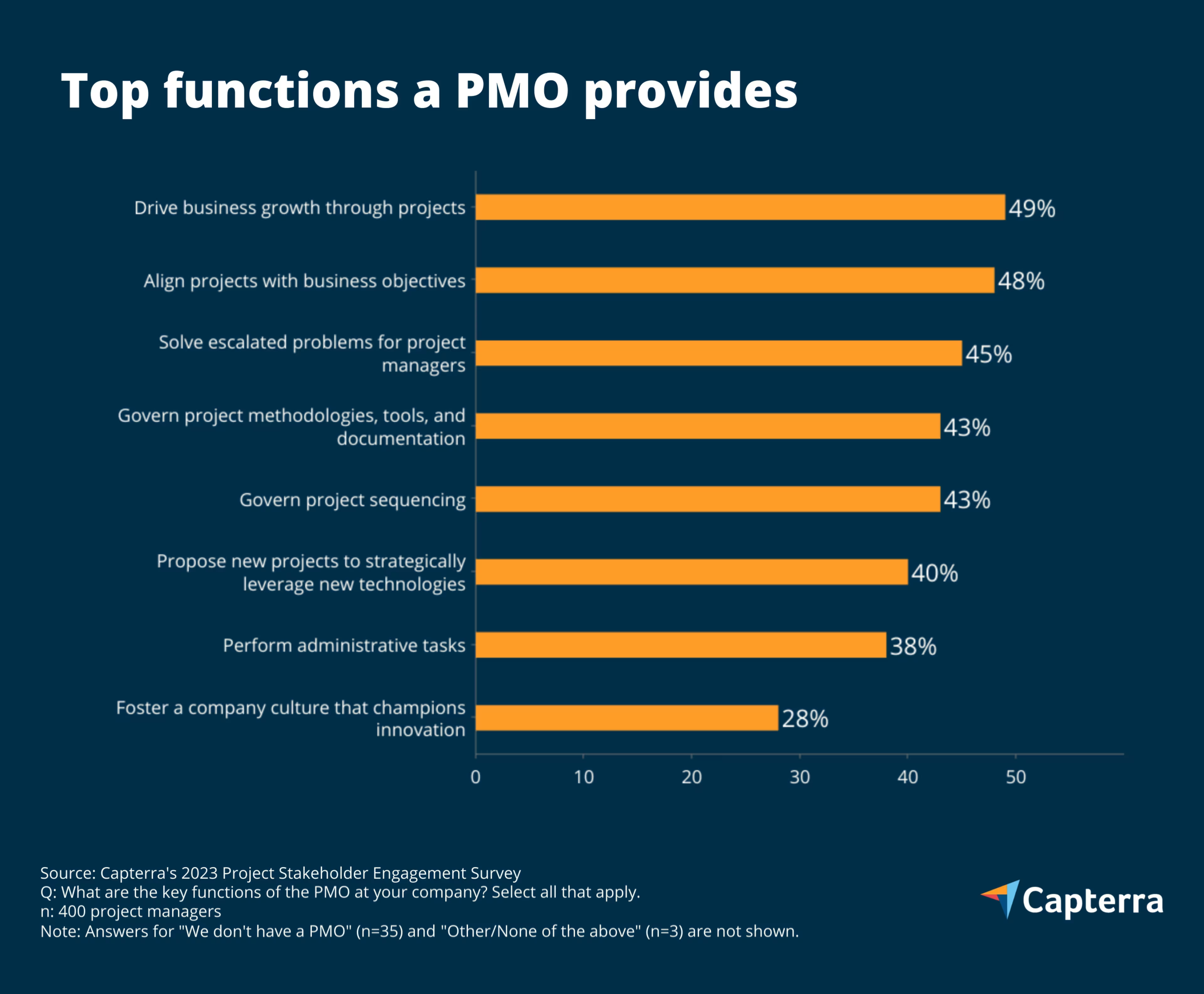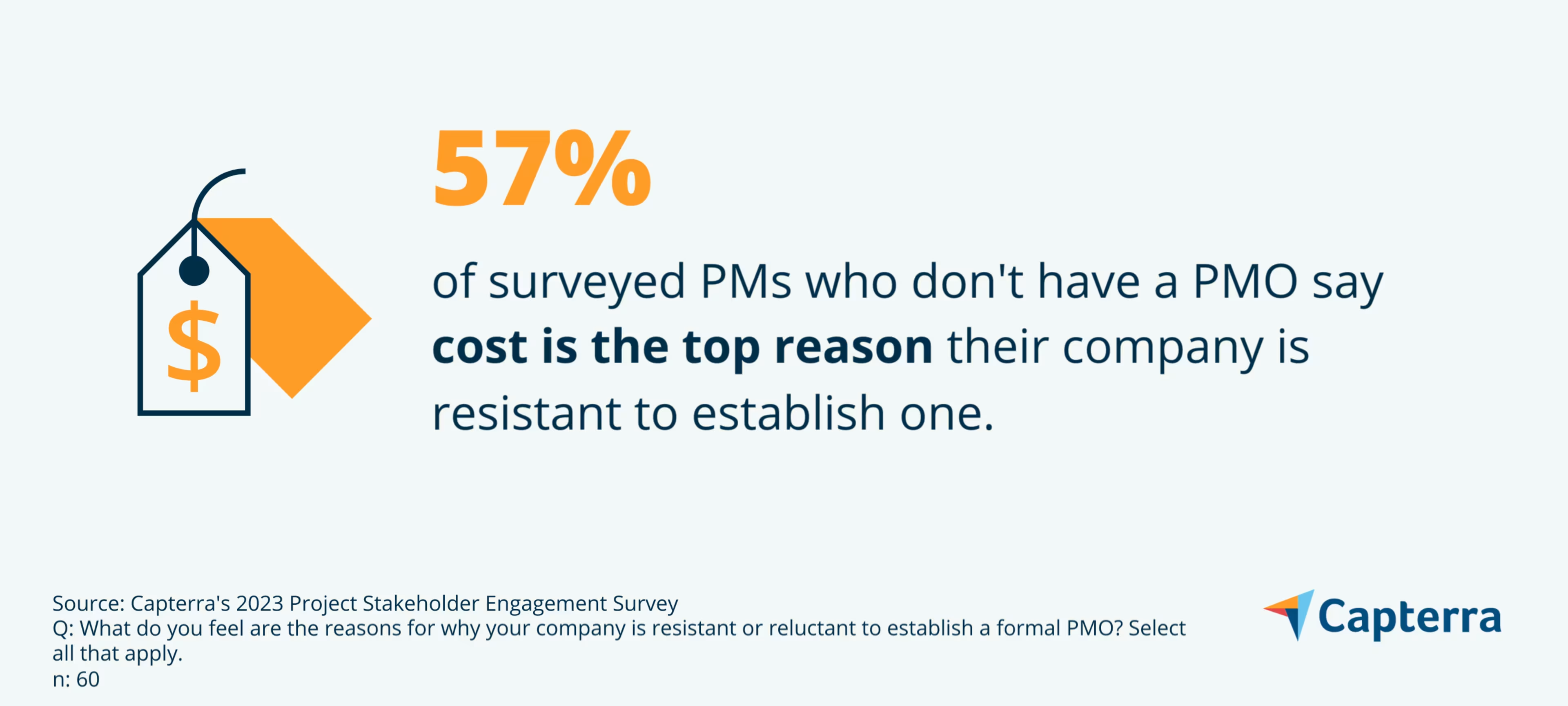Businesses can reduce delays and improve stakeholder engagement with a formal PMO.
A structured project management office (PMO) is not merely an administrative entity—it also serves as a proactive force in addressing challenges and clearing roadblocks quicker than teams without one. In fact, 60% of surveyed project managers (PMs) say that having a formal PMO significantly improves the quality of project management at their company.
Our study reveals the effectiveness of PMOs in navigating project challenges, solidifying their status as key contributors to deliver successful projects. This report will provide insights from not only our research but also from Megan DuBose, manager at the Project Management Institute (PMI).*
Key findings
67% of surveyed project managers say they currently have a formal PMO, another 18% have an informal one.
Unclear roles and responsibilities is the top aspect of project governance PMs think negatively impacts project timelines (58%).
Companies without a PMO are 5x more likely to have minimally informed project sponsors and more than 2x as likely to experience project delays of a month or longer.
What is a PMO?
A project management office (PMO) serves as a centralized hub for project oversight, standardizing processes, and ensuring alignment with strategic objectives. While the size and type of PMO varies widely across businesses, here are the top functions the PMO serves according to our study.

Working as both a navigator and a catalyst, the PMO helps reduce decision-making friction, dismantles roadblocks, and provides clarity on roles and responsibilities. Essentially, the PMO elevates the efficiency, consistency, and overall success of projects across the business.
A third of PMs are working without a formal PMO
The absence of a PMO exacerbates challenges such as stakeholder communication, resulting in uninformed and disconnected stakeholders. Without centralized oversight to drive consistency and set expectations across all projects and project managers, stakeholders often receive fragmented information, leading to a lack of clarity on responsibilities, the project’s status, and potential challenges.
These uninformed stakeholders, in turn, contribute to delays. In fact, 58% of PMs report that unclear roles and responsibilities is the top factor negatively impacting project timelines.
Why wouldn’t a company have a PMO? Of the PMs in our study who don’t have any form of a PMO—formal or not—42% believe having one wouldn’t impact the quality of project management and another 27% think it would decrease the quality. But the biggest concern: cost.

/ Analyst’s tip
Start small and slow, using a cost-effective PMO model focused on addressing immediate pain points. Begin with establishing essential processes for one or two projects and then gradually refine and expand standardization and oversight as benefits are seen. This phased approach allows you to gain some of the positive impacts of a PMO while managing costs and building a compelling case for ongoing investment.
Lack of a PMO leads to uninformed stakeholders and delays
The absence of a centralized oversight office often negatively impacts stakeholder engagement, contributing to miscommunications, missed expectations, and increased instances of rework. Without a PMO, PMs are left navigating the complexities of stakeholder management without support and strategic guidance, which typically results in weak engagement and project delays.
In fact, businesses without a formal PMO are five times more likely to have minimally informed stakeholders.

For this specific aspect of project management, having even an informal PMO increases how well informed your stakeholders are, with only 6% of respondents with an informal PMO reporting minimally informed stakeholders.
Another source of delays reported by PMs is scope changes due to unclear stakeholder prioritization and alignment. Changes to scope often result in delayed decision-making and can require extensive rework to meet the new requirements. Businesses without a formal PMO are twice as likely to see delays last longer than a month, compared to just 9% of businesses with one.
How are PMOs so effective? The PMO’s oversight and strategic alignment foster a proactive approach to identifying and resolving potential roadblocks, curbing delays before they take root. Through risk management and quick intervention, PMOs act as accelerators, moving projects forward, ultimately reducing the need for extensive rework and averting the cascading effects of delays.
What if a PMO isn’t in the cards right now?

Megan DuBose
Manager at the Project Management Institute (PMI)
For the 15% of respondents who don’t have a formal or informal PMO, the odds seem stacked against them. There are steps that project managers can take in their own approach to help drive efficiency, consistency, and overall success of projects across the business.
1. Create your toolkit
Define your project management approach, create a series of tools and templates to aid in documentation and communication (project plan, communication plans, RAID logs, etc.), and identify your processes. Your stakeholders will become accustomed to your ways of working, improving mutual understanding and efficiency.
2. Hone your power skills
PMI’s Pulse of the Profession® 2023[1] explains the top four power skills identified in PMI’s Annual Global Survey and their relationship with project success.
Communication: You’re the main resource responsible for keeping everyone in the know and ensuring alignment for all stakeholders—both at the executive level and your project team. Be able to clearly articulate important project information, such as project scope, status, risks, and decisions, to these audiences.
Problem-solving: Continuously improve and refine your toolkit to meet the evolving needs of the organization. When something no longer enables project success, look into why and change your approach.
Collaborative leadership: Position yourself as an ally to leaders. Help them see the big picture and make data-informed decisions.
Strategic thinking: Break down silos and look cross-functionally. If you are working on multiple projects, are there patterns or impacts that you need to consider?
3. Foster key relationships
Our findings show that companies without a PMO are 5x more likely to have minimally informed project sponsors and more than 2x as likely to experience project delays of a month or longer. Work with key stakeholders in your organization to build and maintain relationships that exist outside of a singular project. Not only will this help you strengthen your clout and rapport when you do work together, but gives you an opportunity to educate others about project management, your ways of working, and what other projects you may be working on within the organization.
Improve project quality and timelines with a PMO
Through meticulous standardization of processes, a PMO provides consistency and alignment, paving the way for increased project success rates. The ability to improve stakeholder engagement, ensure alignment of projects with business objectives, and solve escalated and high-level problems for project managers makes the PMO a catalyst to drive business growth through projects.
The research shows that even having an informal PMO can provide some of the same benefits and should be a goal for businesses struggling to execute projects but not quite ready to invest in a formal project management office.
Recommended Reading
1. What Are Stakeholders in Project Management? A Comprehensive Guide
Learn how to identify stakeholders and maximize their input in project management.
2. The State of AI in PM: Leading Project Manager Unpacks Brand New Capterra Data
By looking at how PMs are feeling about AI's capability for project management, we'll paint a picture of the now and the revolutionary future in the professional project world.
3. How the Most Successful Project Managers Get Their Edge With Emotional Intelligence
The research is clear: EQ can improve team cohesion and decision-making.
